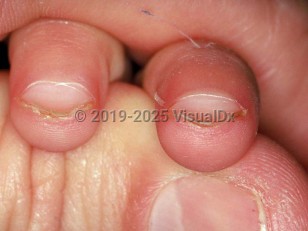Infantile koilonychia - Nail and Distal Digit
Alerts and Notices
Important News & Links
Synopsis

This summary discusses koilonychia in infants. Koilonychia in adults and children is discussed separately.
Koilonychia describes a concave nail condition with a central depression and everted edges, often nicknamed "spoon-nail." Most cases seen in the neonate or young infant are idiopathic and resolve spontaneously.
In infants, physiologic koilonychia is very common, especially on the big toenail. In that location, the condition is enhanced by the crawling motion and disappears progressively with walking. Familial koilonychia is rare and inherited in an autosomal dominant manner. Nails are thin and flat and then develop concavity over time.
Koilonychia may be observed in thin nails of any origin. Koilonychia may be a sign of iron deficiency. Koilonychia may be associated with Kindler syndrome, trichothiodystrophy, focal dermal hypoplasia, familial koilonychia with keratosis pilaris, Turner syndrome, ectodermal dysplasia, monilethrix, and palmoplantar keratoderma.
The pathogenesis of koilonychia is not well understood. According to one hypothesis, it results from a reduction of blood flow to the subungual connective tissue, resulting in a relative depression of the distal nail matrix compared with the proximal matrix.
Koilonychia describes a concave nail condition with a central depression and everted edges, often nicknamed "spoon-nail." Most cases seen in the neonate or young infant are idiopathic and resolve spontaneously.
In infants, physiologic koilonychia is very common, especially on the big toenail. In that location, the condition is enhanced by the crawling motion and disappears progressively with walking. Familial koilonychia is rare and inherited in an autosomal dominant manner. Nails are thin and flat and then develop concavity over time.
Koilonychia may be observed in thin nails of any origin. Koilonychia may be a sign of iron deficiency. Koilonychia may be associated with Kindler syndrome, trichothiodystrophy, focal dermal hypoplasia, familial koilonychia with keratosis pilaris, Turner syndrome, ectodermal dysplasia, monilethrix, and palmoplantar keratoderma.
The pathogenesis of koilonychia is not well understood. According to one hypothesis, it results from a reduction of blood flow to the subungual connective tissue, resulting in a relative depression of the distal nail matrix compared with the proximal matrix.
Codes
ICD10CM:
L60.3 – Nail dystrophy
SNOMEDCT:
66270006 – Koilonychia
L60.3 – Nail dystrophy
SNOMEDCT:
66270006 – Koilonychia
Look For
Subscription Required
Diagnostic Pearls
Subscription Required
Differential Diagnosis & Pitfalls

To perform a comparison, select diagnoses from the classic differential
Subscription Required
Best Tests
Subscription Required
Management Pearls
Subscription Required
Therapy
Subscription Required
References
Subscription Required
Last Reviewed:03/16/2017
Last Updated:09/08/2019
Last Updated:09/08/2019
Infantile koilonychia - Nail and Distal Digit

